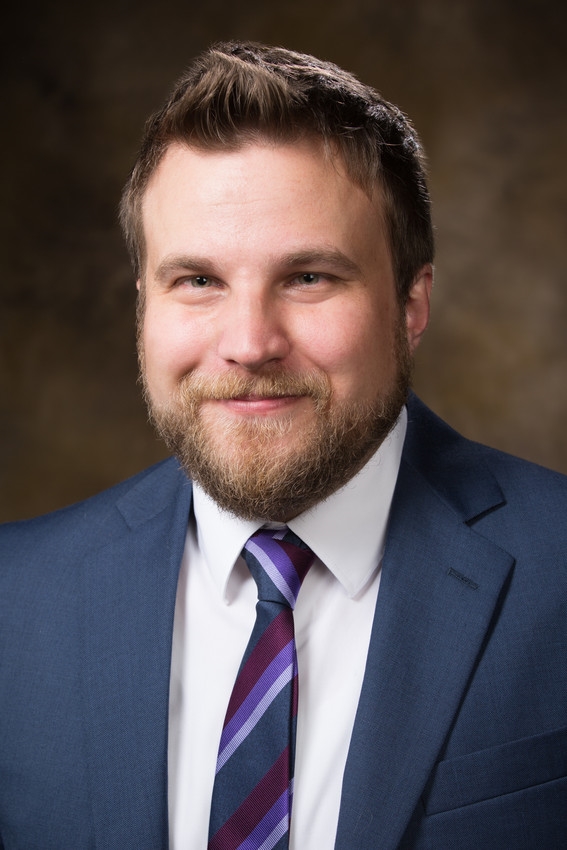Imaging Method Evaluates Cell Functional Changes and Wound Healing
FAYETTEVILLE, Ark. – Kyle Quinn, assistant professor of biomedical engineering at the University of Arkansas, has published a review highlighting recent advances in autofluorescence imaging and discussing its role in evaluating cell metabolism.
Autofluorescence is the emission of light by molecules naturally present in cells and tissue when those molecules have absorbed light.
Quinn and graduate student Olivia Kolenc have published an article in Antioxidants & Redox Signaling, explaining that human cells and tissues contain naturally fluorescent molecules that can be imaged and used to assess cell metabolism for a broad spectrum of biomedical applications, including tissue engineering and regenerative medicine.
Autofluorescence imaging of these naturally fluorescent molecules – nicotinamide adenine dinucleotide (NADH) and flavin adenine dinucleotide (FAD) – can allow researchers to assess the structural organization of mitochondria and biochemical details related to cell metabolism. This can be done through a measurement called an optical redox ratio, which quantifies the relative concentrations of NADH and FAD. The three-dimensional distribution of NADH and FAD within cells can be quantified non-invasively in living tissue by using a multiphoton microscope.
Mitochondria are the organelles – or specialized structures – within cells that are responsible for respiration and energy production.
Traditionally, this imaging technique has been used to monitor cell metabolism during hypoxia and cancer development, Quinn said. But he and Kolenc expect that continued improvement in instrumentation and analysis with these methods will lead to wider applications and further advances in basic science, preclinical research and clinical management of disease. For example, part of Quinn’s research focuses on applying this imaging technique to the study of wound healing.
Quinn is also a co-author of a new study by researchers at Tufts University, where he was a postdoctoral fellow after receiving his doctorate at the University of Pennsylvania. The study highlights some of these new applications and methods for autofluorescence imaging of NADH and FAD.
“Autofluorescence intensity can be a useful metric to noninvasively assess metabolic and functional cellular changes for a variety of biochemical applications,” Quinn said. “We here at the U of A are particularly excited about its use in evaluating wound healing.”
Quinn’s research is supported by the National Institutes of Health, Department of Defense, and the Arkansas Biosciences Insititute. In September of 2017, he received a $1.7 million grant from the NIH to continue developing autofluorescence imaging methods to quantify and understand age-related delays in skin wound healing.
Also in 2017, Quinn published research demonstrating that during the weeks following a heart attack, the injured heart wall acquires more collagen fibers that are significantly less stiff due to a lack of naturally fluorescent fiber crosslinks. That study appeared in Nature Publishing Group’s Scientific Reports.
About the College of Engineering: The University of Arkansas College of Engineering is the largest engineering program in the state of Arkansas. Over the past decade, the college has experienced unprecedented growth. Undergraduate enrollment has doubled since 2007, and total enrollment in the college is now over 4,000 students. The College of Engineering offers graduate and undergraduate degrees in nine engineering fields, as well as incorporating distance learning and interdisciplinary programs. Faculty in the college conduct research in many key areas, including electronics, energy, biomedical and healthcare engineering, materials science, transportation and logistics.
About the University of Arkansas: The University of Arkansas provides an internationally competitive education for undergraduate and graduate students in more than 200 academic programs. The university contributes new knowledge, economic development, basic and applied research, and creative activity while also providing service to academic and professional disciplines. The Carnegie Foundation classifies the University of Arkansas among only 2 percent of universities in America that have the highest level of research activity. U.S. News & World Report ranks the University of Arkansas among its top American public research universities. Founded in 1871, the University of Arkansas comprises 10 colleges and schools and maintains a low student-to-faculty ratio that promotes personal attention and close mentoring.
Topics
Contacts
Kyle Quinn, Assistant Professor
Biomedical Engineering
479-575-5364,
kpquinn@uark.edu
Matt McGowan, science and research communications officer
University Relations
479-575-4246,
dmcgowa@uark.edu
Headlines
Four Students Named Goldwater Scholars; Two Earn Udall Honorable Mentions
Four U of A students have received the prestigious Goldwater Scholarship, an award for top students in mathematics, science, and engineering.
Cross-Campus Collaboration Culminates in New Outdoor Geological Installation
Grand opening event to celebrate the new GeoLab installation at the U of A’s Gearhart Hall courtyard is set for May 3. The installation will be open to the public year-round.
First Students to Use Online Degree to Hone Nursing Leadership, Elevate Patient Care
Hanna Baxendale and Wendi Kimbrell will begin coursework in the Doctor of Nursing Practice-Executive Master of Business Administration program offered by the Eleanor Mann School of Nursing and Walton College.
Join the Office for Sustainability on a Final Cruise to Campus
Cruise to Campus Wednesdays have fostered a gathering space for individuals interested in biking to campus. Drop by the Old Main Lawn from 7:30-10 a.m. Wednesday for coffee, something to eat and conversation.
Fay Jones School Student Ambassador Program Gives Voice to Design Students
The student ambassador program at the Fay Jones School of Architecture and Design is built to connect top design students with their school, its alumni, its future students and others inside and outside the school.





